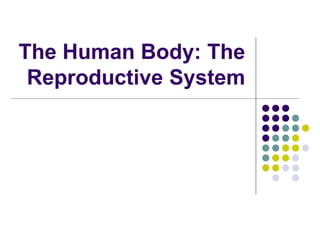
Reproductive System.ppt
- 1. The Human Body: The Reproductive System
- 2. Review Mitosis is the type of cell division that occurs in non-reproductive cells. Produces exact copies of the parent cell Meiosis is cell division that occurs in reproductive cells; gametes. Produces egg and sperm cells with half the genetic material of the parent cells. 23 chromosomes are contained in gametes; this is so that when egg and sperm meet, they produce offspring with 46 chromosomes.
- 3. Organs of the Male Reproductive System Penis Urethra Vas Deferens Scrotum Testes Bladder* *Not a part of the reproductive system
- 4. External Organs of the Male Reproductive System Penis: the external reproductive organ, urethra passes through the penis and allows urine and semen to exit the body. Scrotum: a sac or pouch which holds the testes. The function of the scrotum is to maintain the proper temperature of the testes. Sperm is destroyed unless a temperature of 97o is maintained.
- 5. Internal Organs of the Male Reproductive System Bladder*: holds urine prior to urination. Urine leaves the bladder via the urethra. Urethra: a tube which allows urine and semen to exit the body. Connects to the bladder Vas deferens: a tube which connects the testes to the urethra and allows semen to exit the body. Testes: two glands which produce sperm and hormones (testosterone)
- 6. Organs of the Male Reproductive System Let’s fill in our diagrams of the male reproductive system.
- 8. Organs of the Female Reproductive System Vagina Cervix Uterus Fallopian Tubes Ovary
- 9. Organs of the Female Reproductive System Vagina: also called the birth canal, a tube leading from the uterus to the outside of the body. Cervix: the lower portion of the uterus; where the vagina and uterus meet. Uterus: a hollow, fist-sized organ located between the bladder and rectum. Fallopian Tubes: also called oviducts; are two tubes connecting the uterus with the ovaries.
- 10. Organs of the Female Reproductive System Ovaries: small organs on the ends of the Fallopian tubes responsible for the production and release of eggs (ova-pl). Females are born with all of the eggs they will ever produce. Ovaries alternate the release of eggs each month. Like testes, the ovaries produce hormones- estrogen. This release of the ova is called ovulation.
- 11. Organs of the Female Reproductive System Lets label the parts of the female reproductiv e system now.
- 13. The Menstrual Cycle The menstrual cycle typically lasts 28 days; approximately 1 month. One cycle is the amount of time from the beginning of one period to the beginning of the next period. The beginning of a period is marked by the release of the blood and lining from the inside of the uterus. This flow of blood typically lasts 3-7 days and is called menstruation.
- 14. The Menstrual Cycle After menstruation, the ovaries release hormones that tell the uterus to grow a new lining and prepare to receive a new egg. As the uterus prepares a new lining, one of the ovaries releases an egg. This is called ovulation. Ovulation occurs about halfway through a woman’s cycle. The egg travels through the Fallopian tube. If it is not fertilized it breaks down and is released with the lining and blood of the uterus.
- 18. The Menstrual Cycle and Fertilization If the egg is fertilized by a sperm cell, the egg will implant in the lining of the uterus and begin to develop. Zygote: The first cells of a new organism; the time from fertilization to implantation. Embryo: The zygote is called an embryo from implantation to 8 weeks. Fetus: After 8 weeks of development, the embryo is known as a fetus.
- 19. END
- 21. Genetics & Inheritance Gregor Mendel: 1822-1884. Austrian monk who is often called the “Father of Genetics” Studied the inheritance of traits in pea plants His research has led to a greater understanding of dominant and recessive traits, as well as how to predict the probability of those traits in offspring
- 22. Genetics & Inheritance: Important Vocabulary Phenotype: the observed traits of an organism. Example: hair color Genotype: the genetic makeup of an organism. Example: the gene that says what your hair color will be. Gene: a region of DNA that describes a trait of an organism. Example: eye color gene Allele: a different form of a gene Example: brown eye color allele, blue eye color allele
- 23. Genetics & Inheritance: Important Vocabulary Dominant allele: Traits that mask the effect of other traits Recessive allele: Traits that are masked by dominant traits Examples of dominant and recessive traits Heterozygous: the organism has one dominant allele and one recessive allele. Example: Bb Homozygous: the organism has either 2 dominant alleles or 2 recessive alleles. Example: BB or bb
- 24. Predicting patterns of heredity: Punnett Squares A man who is heterozygous for brown eyes marries a woman who is homozygous recessive for blue eyes. What are the phenotypes, genotypes of their 4 children? B b b b Bb bb Bb bb
- 25. Predicting patterns of heredity: Pedigree Charts A pedigree chart is a family tree showing genetic information. A represents males, while represents females. or means that the individual shows the trait. Married people: Children:
- 26. Predicting patterns of heredity: Pedigree Charts Pictures of the traits you can use in your pedigree chart.
- 27. Twins Multiple eggs are released or there is more than one ovulation. Both (or more) eggs are fertilized and you have fraternal twins. One egg is released but splits in two. Identical twins are made. If the egg does not completely split in two, conjoined twins are produced.
- 28. Chromosomal Disorders http://www.pregnancy- info.net/chromosomal_abnormalities.html http://en.wikipedia.org/wiki/List_of_genetic_di sorders http://www.familyvillage.wisc.edu/Lib_chro.ht m http://www.thetech.org/genetics/ask.php?id=2 09